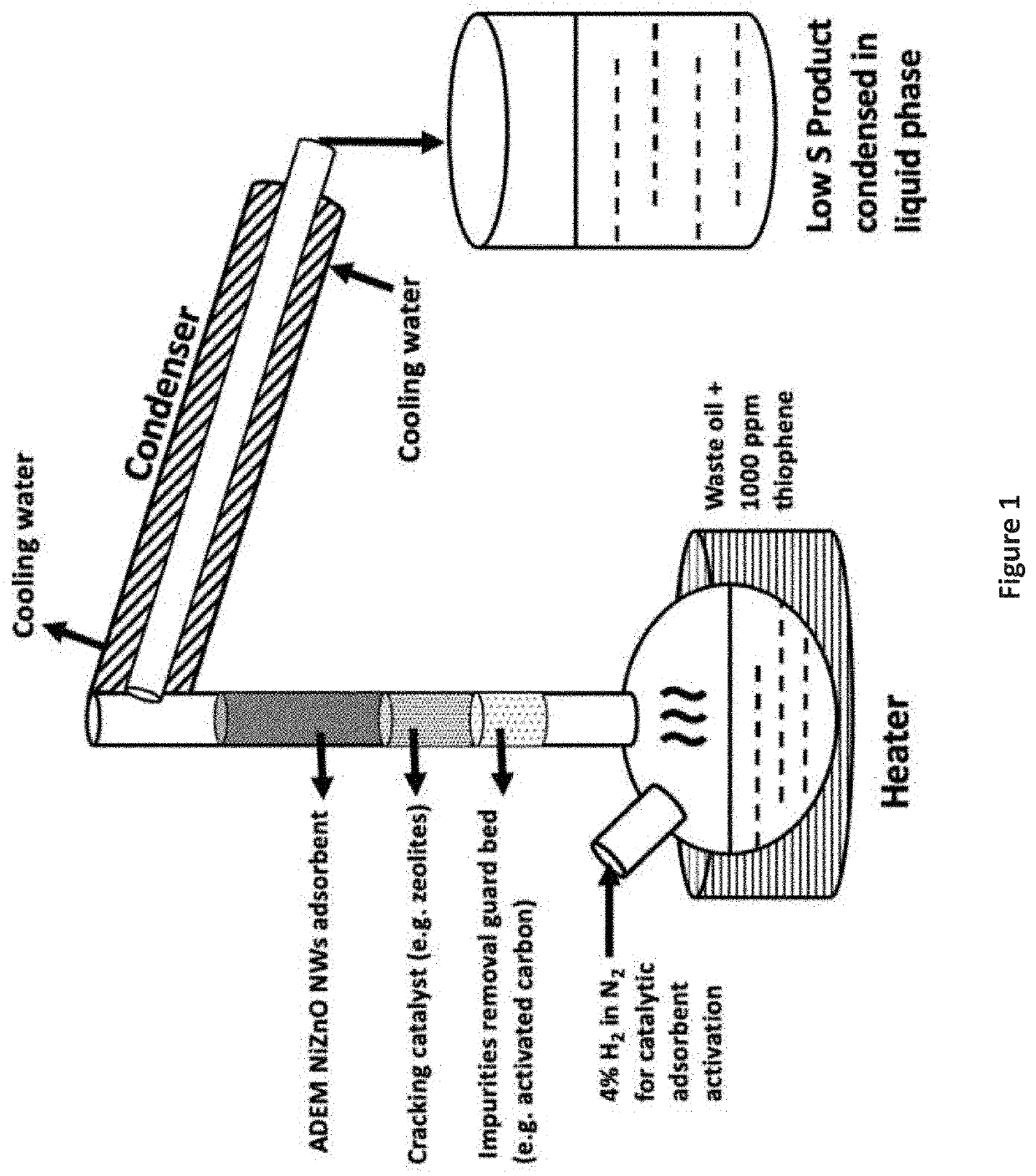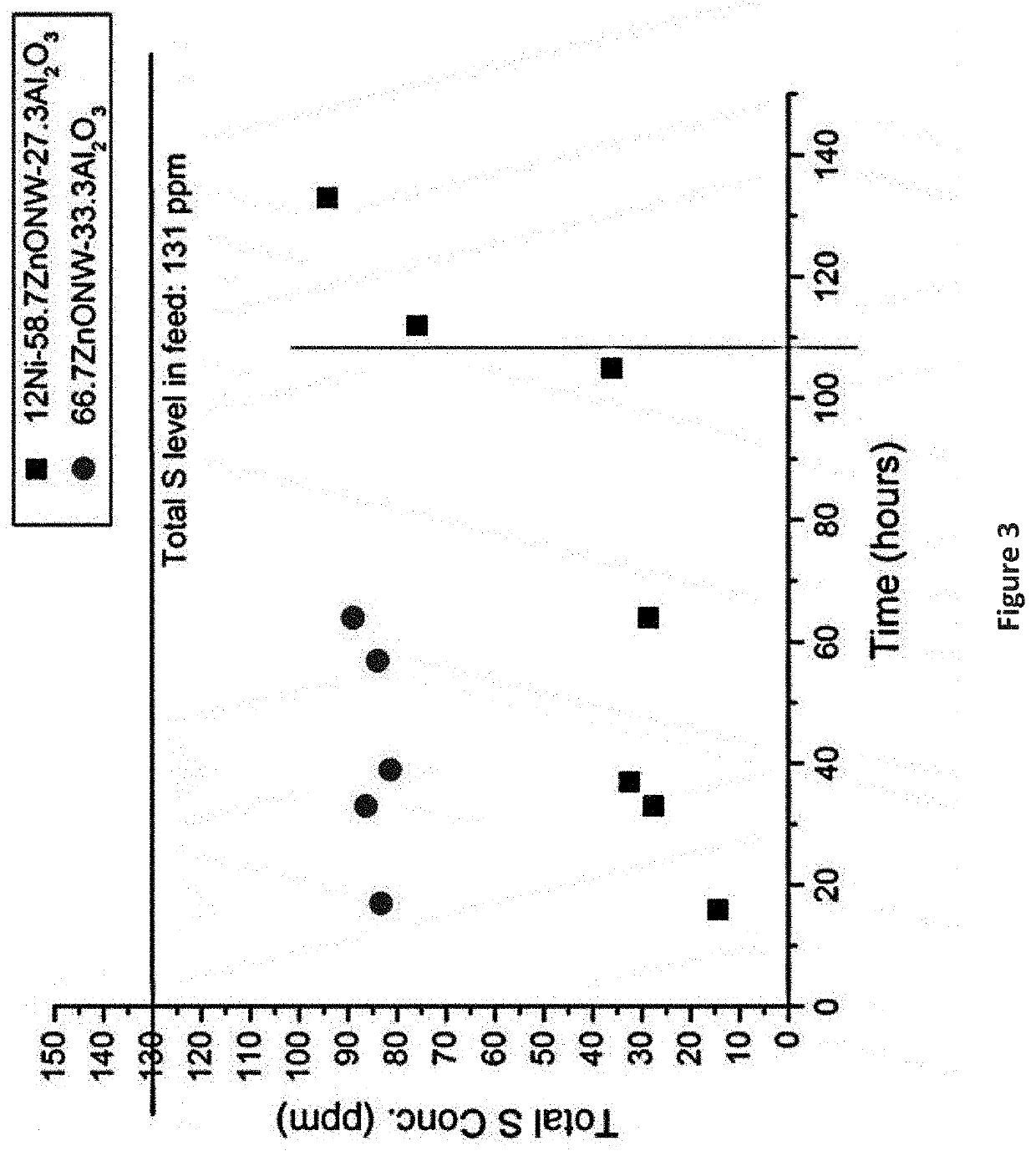Desulfurization and Sulfur Tolerant Hydrogenation Processes of Hydrocarbon Feedstocks
a hydrogenation process and hydrocarbon feedstock technology, applied in the field of desulfurization and sulfur tolerant hydrogenation processes of hydrocarbon feedstocks, can solve the problems of air pollution, catalyst deactivation and corrosion in the refining process, and contain sulfur, and achieve the effect of reducing the concentration of sulfur
- Summary
- Abstract
- Description
- Claims
- Application Information
AI Technical Summary
Benefits of technology
Problems solved by technology
Method used
Image
Examples
example 6
Decorated Nanowire Example 6
[0061]Using the Apparatus Arrangement as shown in FIG. 1, about 15 g of the 12% Ni-58.7% ZnO-29.3% Al2O3 decorated nanowire adsorbent from Example 3 is packed into a fixed bed reactor along with 5 g activated carbon and 5 g molecular sieves 13X, with the materials packed into the reactor such that the feedstock initially contacts the activated carbon and then the molecular sieves 13X and then the decorated nanowire adsorbent, and then the feedstock exits the reactor. Prior to introduction of the feedstock, the decorated nanowire adsorbent is pretreated and reduced, and the hydrogen gas flow is stopped. The reactor is then heated to a temperature of about 390° C. and atmospheric pressure. The hydrocarbon feedstock, a waste lube oil with 900 ppm sulfur, is preheated to vaporize the feedstock. The feedstock is pumped from a bottom inlet of the reactor and passes through the adsorbent at a liquid hourly space velocity of 1 to 3 h−1 before exiting at a top out...
example 7
Decorated Nanowire Example 7
[0062]The feedstock exiting the outlet from Example 6 is then fed through fresh 12% Ni-58.7% ZnO-29.3% Al2O3 decorated nanowire adsorbent in a reactor and under the same conditions as described in Example 6 to further reduce the sulfur concentration. Table 3 shows the sulfur concentration from samples recovered at the outlet after various times on-stream from this second-stage processing.
TABLE 3Time on stream (h)LHSV (h−1)Sulfur concentration at outlet (ppm)3.5253.512.216714.51766.60.558.518.70.543.825.20.547
example 8
Decorated Nanowire Example 8
[0063]Example 6 is repeated with 17.5 g of the 12% Ni-58.7% ZnO-29.3% Al2O3 decorated nanowire adsorbent, and the waste lube oil feedstock is replaced with a diesel feed obtained from a local gas station spiked to 470 ppm sulfur with 95% thiophene and 5% a combination of benzothiophene (BT), dibenzothiophene (DBT), 4,6-dimethyldibenzothiophene (DMDBT), and 4-methyldibenzothiophene (MDBT). More than 95% of thiophenes and benzothiophenes are removed during 48 hours of operation.
PUM
| Property | Measurement | Unit |
|---|---|---|
| Temperature | aaaaa | aaaaa |
| Temperature | aaaaa | aaaaa |
| Temperature | aaaaa | aaaaa |
Abstract
Description
Claims
Application Information
 Login to View More
Login to View More - R&D
- Intellectual Property
- Life Sciences
- Materials
- Tech Scout
- Unparalleled Data Quality
- Higher Quality Content
- 60% Fewer Hallucinations
Browse by: Latest US Patents, China's latest patents, Technical Efficacy Thesaurus, Application Domain, Technology Topic, Popular Technical Reports.
© 2025 PatSnap. All rights reserved.Legal|Privacy policy|Modern Slavery Act Transparency Statement|Sitemap|About US| Contact US: help@patsnap.com



